The United States Navy
..
The US Navy in World War I
.
American sea power had grown to impressive
scale by 1917,
when the country entered World War I.
.
The Navy secured the Atlantic with five battleships,
many cruisers, and nearly a hundred destroyers.
These were supplemented by patrol ships and
other escort vessels to defend troop and food convoys sailing to Britain
and France.
The most important Navy combat task was the
antisubmarine campaign waged against German U-boats. This was a resounding
success. |
..... |
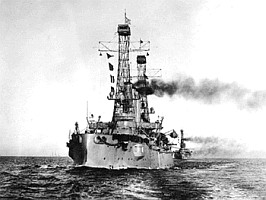 The USS Missouri was
one of the five US Atlantic Fleet battleships during WWI.
The USS Missouri was
one of the five US Atlantic Fleet battleships during WWI.
|
.
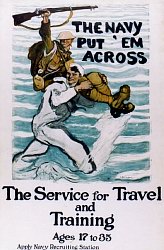 |
.v |
Over two million soldiers were transported
from the United States across the enemy submarine-infested Atlantic Ocean
to stations in Britain and France.
The troop transports were mostly shepherded
by American naval vessels. Not one soldier was lost by enemy sub action
during these outward voyages.
Left Picture: World War I Navy
recruiting poster advertising the Navy's role in transporting American
troops to the War Zone. |
.
| An important task was placing a mine barrage
at the German entrance to the North Sea, and American ships laid tens of
thousands of mines by 1918, as part of a joint US-British mine-laying effort.
Right Picture: U.S. Navy minelayers
laying the North Sea Mine Barrage, 1918. At left, British destroyers are
covering the formation's flank with a smoke screen. |
.. |
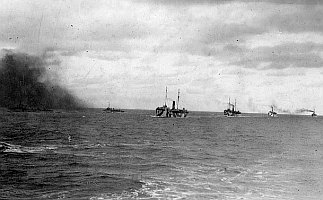 |
.
Another important aspect of Navy experience
during World War I was the employment of women on a large scale. In March
1917, the US Civil Service Commission determined that it could not meet
the increased manpower needs of the naval shore stations for clerical assistance,
if the United States entered the war.
.
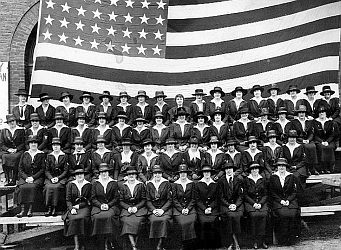 |
..v |
Fortunately, for both naval and women’s progress,
the Act of August 19, 1916, that established the Naval Reserve Force, never
specified the term "male."
Therefore, women were declared eligible for
enrollment in order to meet increased activity levels of the wartime navy.
Left Picture: Group photograph
of "Yeomanettes" taken at the Portsmouth Navy Yard, Kittery, Maine
in 1918. |
.
This large-scale utilization of women, who
were designated as yeomen (F), commenced immediately after America entered
hostilities, which allowed the release of enlisted sailors for sea duty.
.
| When the Armistice ended World War I, 11,275
female yeomen were in naval service. Many filled jobs beyond clerical duties,
such as translators, draftsmen, fingerprint experts, camouflage designers
and recruiting agents.
Right Picture:Female Yeomen working
in an office in the Main Navy or Munitions Buildings, circa 1919. |
..... |
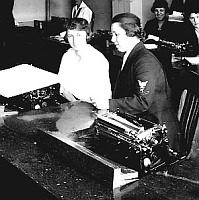 |
.
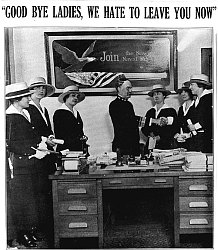 |
........ |
These women were stationed in the United States
and overseas in France, as well as in Guam, the Panama Canal Zone and Hawaii.
By 31 July 1919, all yeomen (F) were released
from active duty in the Navy.
Left Picture:
Rear Admiral Joseph L. Jayne,
USN, says "adieu" to some of the "Yeomanettes" who served in Twelfth Naval
District offices in San Francisco |
.
[ I. Development ]..[
II. Facts about the WAVES ]..[
III. Uniforms ]..[
IV. Sources ]
|
